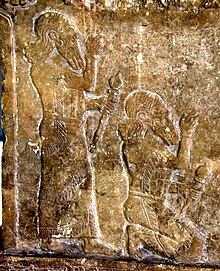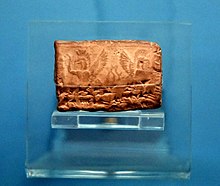Middle Assyrian Empire
The reign of Tukulti-Ninurta I marked the height of the Middle Assyrian Empire and included the subjugation of Babylonia and the foundation of a new capital city, Kar-Tukulti-Ninurta, though it was abandoned after his death.Though Assyria was left largely unscathed by the direct effects of the Late Bronze Age collapse of the 12th century BC, the Middle Assyrian Empire began to experience a significant period of decline roughly at the same time.On account of political realism however, the true situation was most often diplomacy with adversaries of equal rank, such as Babylonia, and conquest only of smaller and military inferior states in the near vicinity.[12] Ashur-uballit, doubtlessly watching the conflict between Mitanni and the Hittites closely out of interest in expanding Assyria, directed much of his attention to the lands south of his realm.[21][22] This arrangement, placing the Mitanni lands under the rule of a lesser branch of the royal family, suggests that the Assyrian elites in the heartland had only a marginal interest in the new conquests.When Mursili's successor Hattusili III reached out to Shalmaneser in an attempt to forge an alliance, probably due to recent losses against Egypt, he was insultingly rejected and called a "substitute of a great king".[24] He had, according to historian Stefan Jakob, "an unconditional will to create something that would last forever"[23] and his wide-ranging conquests brought the Middle Assyrian Empire to its greatest extent.Tukulti-Ninurta eventually emerged as the winner,[26] conquering Babylonia c. 1225 BC,[27] dragging Kashtiliash back to Assyria as a prisoner, and assuming the ancient title "king of Sumer and Akkad".[24] Tukulti-Ninurta is recorded to have complained to the Hittite king Šuppiluliuma II, at this point an ally of Assyria and expected to cooperate militarily, that he had "remained silent" on the "illegal seizure of power" of Adad-shuma-usur.[40] Inscriptions from the late reign of Tukulti-Ninurta showcase increasing internal isolation, as many among the powerful nobility of Assyria grew dissatisfied with his rule, especially after the loss of Babylonia.[29] Though some historians have attributed the assassination to Tukulti-Ninurta's moving the capital away from Assur, a possibly sacrilegious act,[43] it is more probable that it was the result of the growing dissatisfaction during his late reign.[29] Modern researchers tend to varyingly ascribe the collapse to large-scale migrations, invasions by the mysterious Sea Peoples, new warfare technology and its effects, starvation, epidemics, climate change and unsustainable exploitation of the working population.[24] Mutakkil-Nusku began a conflict with the Babylonian king[48] Itti-Marduk-balatu[49] over control of the city of Zanqi or Zaqqa,[48] which continued in the reign of his son and successor Ashur-resh-ishi I (r. 1132–1115 BC).The cities of northern Syria, which had ceased to pay tribute decades prior, were reconquered and the Kaskians and Urumeans, tribes who had also settled in the region, voluntarily submitted to him immediately upon the arrival of his army.Though he was one of the most powerful kings of the Middle Assyrian period, succeeding in imposing tribute from as far away as Phoenicia, his achievements were not long-lasting and several territories, especially in the west, were likely lost again before his death.Though he shared his father's ambition, and claimed the title "lord of all" after his victorious campaigns in Syria, Babylonia and the northeastern mountains, Ashur-bel-kala was ultimately unable to surpass Tiglath-Pileser and his successes were built on shaky foundations.Documents as old as from the reign of Tiglath-Pileser I demonstrate that even at that early stage, Aramean raids penetrated deep into the Assyrian heartland, at one point reaching Assur itself.The inscriptions of early Neo-Assyrian kings typically treat their wars of expansions as reconquests of territory lost during the decline of the Middle Assyrian Empire.[68] As Assyria's power grew, the kings began to employ an increasingly sophisticated array of royal titles far more autocratic in nature than the old iššiak Aššur.Adad-nirari I's inscriptions required 32 lines to be devoted just to his titles, which included, among others, nêr dapnūti ummān kaššî qutî lullumî u šubarî ("defeater of the aggressive armies of the Kassites, Qutû, Lullumu, and Šubaru"), šakanki ilāni ("appointee of the gods") and rubā’u ellu ("holy prince").One of Tukulti-Ninurta's foundation deposits, relating to the construction of Kar-Tukulti-Ninurta, included the message "He who destroys that wall, discards my monumental inscriptions and my inscribed name, abandons Kar‐Tukulti‐Ninurta, my capital, and neglects (it): may the god Ashur, my lord, overthrow his sovereignty, smash his weapons, bring about the defeat of his army, diminish his borders, decree the end of his reign, darken his days, vitiate his years (and) destroy his name and his seed from the land".These tablets, attested from the time of Adad-nirari I onwards, summarized data on the available manpower, calculated required rations and provisions and documented responsibilities and tasks.According to administrative records on construction work at the royal palaces of Kar-Tukulti-Ninurta and Assur, these projects were completed with workforces of about 2,000 men, divided into recruits from various cities (ḫurādu), mostly gathered through the ilku system,[i] engineers or architects (šalimpāju), carpenters and religious functionaries.[90] Because of the limited surviving material, information regarding social life and living conditions of the Middle Assyrian period is generally available in detail only for the socio-economic elite and upper classes of society.At the top of Middle Assyrian society were members of long-established and large families, called "houses", who tended to occupy the most important offices within the government.[91] It is clear from surviving documents that corruption among royal officials, who at times used the resources provided to them by the Assyrian government to generate private profits, was a large problem.They could for instance loan money to private individuals and charge highly unfavorable interests, sometimes amounting to up to 100 percent, in addition to demanding goods such as sheep and vessels.The most prominent foreign ethnic groups within the Middle Assyrian Empire were the Hurrians (incorporated through conquests in northern Syria), Kassites (descendants of deportees and captives from the Babylonian campaigns) and Arameans.[109] The most frequent users of the roads, at least in terms of appearances in the surviving source material, were members of the Assyrian administration; couriers of officials and royal messengers, sometimes accompanied by an escort for protection.[91] It is possible that the dominant military role of Ashur in the Middle Assyrian period was the result of the theology promulgated by the Amorite conqueror Shamshi-Adad I, who conquered Assur in the 19th century BC.



































Kar-Tukulti-NinurtaAkkadianHurrianAmoriteAramaicAncient Mesopotamian religionMonarchyNotable kingsAshur-uballit IAdad-nirari IShalmaneser ITukulti-Ninurta INinurta-apal-EkurAshur-resh-ishi ITiglath-Pileser IAshur-dan IIBronzeIron AgeOld Assyrian periodMitanniNeo-Assyrian EmpireTurkeyAssyriaEarly Assyrian periodNeo-Assyrian periodPost-imperial periodHistory of the AssyriansAssyrianempireAssyrian kingAncient Near EastMesopotamiaBabyloniaLate Bronze Age collapseAshur-dan IMediterraneanAshur-bel-kalaArameanAmarna letter EA 15AkhenatenTigrisTaurus MountainsUpper ZabShamshi-Adad IpharaohsHittite kingsHittiteŠuppiluliuma IArtashumaraTushrattaArtatama IIShuttarna IIIArraphaLittle ZabBabylonian kingsBurnaburiash IIpharaohKara-hardashNazi-BugashKurigalzu IIEnlil-nirariArik-den-iliSugaguday's journeyArinnuShattuara IWasashattaKhaburRapiquNazi-MaruttashBattle of Kār IštarShattuara IIWashukannigrand vizierking of HanigalbatNimrudMursili IIIHattusili IIILevantBattle of NihriyaTudḫaliya IVBabu-aha-iddinaKashtiliash IVTukulti-Ninurta EpicpropagandaDiyala RiverSipparDur-Kurigalzuking of Sumer and AkkadPersian GulfEnlil-nadin-shumiKadashman-Harbe IIAdad-shuma-iddinaStatue of MardukMardukUpper SeaLower Seafrom the four quartersShamashAdad-shuma-usurŠuppiluliuma IINeo-AssyrianAshur-nadin-apliIli-ipaddaAshur-nirari IIIEnlil-kudurri-usurKassite dynastySea PeoplesBabylonian ChroniclesZababa-shuma-iddinNinurta-tukulti-AshurMutakkil-NuskuItti-Marduk-balatuNebuchadnezzar Isiege enginesNinurta-nadin-shumiking of the universeking of the four quartersMushkiKaskiansUrumeansTerracottawar chariotsMarduk-nadin-ahhePhoeniciaAsharid-apal-Ekur